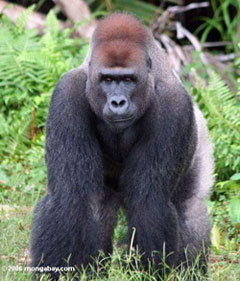
Ebola Threatens to Kill Off Gorillas in Africa
The New York Times
07 Dec 2006
D Grady
Photo courtesy of mongabay.com
The Ebola virus has killed from 3,500 to 5,500 gorillas in one region of the Congo Republic since 2002, and its continued spread, along with hunting, could wipe out the species, researchers are reporting today. “A lot of animals are dying,” said Dr. Peter D. Walsh, an ecologist at the Max Planck Institute for evolutionary primatology in Leipzig, and an author of a report being published today in the journal Science. “There’s a massive decline.”
Several vaccines have been developed that work in animals in the lab, including monkeys, and Dr. Walsh is eager to test them on gorillas in the wild by injecting the animals with darts or putting an oral vaccine in food. By tracking the spread of the virus and vaccinating animals in its path, it might be possible to stop outbreaks, he said. Other researchers say that although vaccination might be feasible, it is not known whether the vaccine could made into a heat-stable version or an oral form. In addition, there would be miles of red tape to cut through, involving various conservation groups, donors and governments.
No Exotic Pets for Christmas [Editorial]
The Pocono Record
08 Dec 2006
Considering buying an exotic pet as a Christmas gift? Animal lovers almost universally warn against introducing any new pet during the holiday season, even the familiar puppy or kitten, when so much is going on that it's hard to provide the proper care and attention. There ought to be a universal warning against non-domestic-animal purchases at this busy time — and year-round. Wild animals are the least suitable gift people should bring home for the holidays.
In the first place, collecting wild animals depletes the supply in the wild and can upset the local ecosystem. When collecting reaches a certain level it can drive a species extinct. Wild animals, and plants too, are already fighting habitat loss and global warming. Human predation, either for collectors and naïve "pet" owners just looking for something out of the ordinary to call their own, only worsens their struggle.
'GreeneChip' -- New Diagnostic Tool that Rapidly and Accurately Identifies Multiple Pathogens
Biology News Net
07 Dec 2006
Researchers in the Greene Infectious Disease Laboratory at Columbia University Mailman School of Public Health and their colleagues in the WHO Global Laboratory Network have developed a new tool for pathogen surveillance and discovery—the GreeneChip System. The GreeneChip is the first tool to provide comprehensive, differential diagnosis of infectious diseases, including those caused by viruses, bacteria, fungi, or parasites.
In addition, it is the first tool that can be used on a wide variety of samples, including tissue, blood, urine, and stool, allowing for the rapid identification of pathogens in a variety of laboratory and clinical settings.
The GreeneChip system and its application in an outbreak investigation when other methods failed to implicate a microorganism in a fatal hemorrhagic fever case is described in the January 2007 issue of the CDC’s Emerging Infectious Diseases (online December 6 at www.cdc.gov/EID/13/1/06-0837.htm).
Chicks and Wild Ducks Dunnit
NewScientist.com
08 Dec 2006
Ever since H5N1 bird flu spread across Eurasia last year, battle has raged between those who blame it all on migrating wild birds and others who reckon it's the poultry. In fact it was both.
Marm Kilpatrick of the Consortium for Conservation Medicine in New York and colleagues analysed how the virus travelled by comparing H5N1 gene sequences against volumes of bird trade and migration. They found that the poultry trade explains the virus's spread in Asia but migration explains it in Europe.
W.Va. Deer Illegally Taken to Maryland
The Cumberland Times-News
08 Dec 2006
MA Sawyers
Spokesmen for natural resources agencies in two states have confirmed that a deer killed in a West Virginia county where chronic wasting disease has been found was illegally transported into Maryland recently.
“Our Natural Resources Police got a call from a meat processor in Frederick County telling them he had been brought a deer from the containment zone in West Virginia,” said Steve Bittner, a biologist for the Maryland Wildlife and Heritage Service. “We had made the meat processors in the state aware that deer from a certain part of Hampshire County were not supposed to be brought into Maryland.”
Earlier this year, the West Virginia Wildlife Resources Section declared all of Hampshire County north of U.S. Route 50 as a containment zone from which only deer meat, but not entire carcasses, could be removed.
Recently Published Journal Articles
Ebola Outbreak Killed 5000 Gorillas (Abstract only)
Science
M Bermejo and et al.
Predicting the Global Spread of H5N1 Avian Influenza (Abstract only)
Proceedings of the National Academy of Sciences (PNAS)
AM Kilpatrick
____________________________________________________________________





1 comment:
Hi... I just want to coment on the subject matter and how well you set this blog up.
Happy holiday's
Vince
Post a Comment